The Dell XPS 15 9550 Review: Infinity Edge Lineup Expands
by Brett Howse on March 4, 2016 8:00 AM ESTGPU Performance
Other than the base model Core i3 powered XPS 15, all of the other models feature a 2 GB NVIDIA GTX 960M graphics card. The outgoing XPS 15 that we last reviewed featured a GT 750M, so the move to a Maxwell card should offer a better overall experience and with a more efficient design, which may come into play with the smaller chassis on the new XPS 15 9550.
The laptop was run through our standard gaming workloads. Of note is the Lenovo Y700 which has the same CPU but a 4 GB version of the GTX 960M, compared to the 2 GB one offered by Dell. We’ll see if that comes into play in the games we have here. The higher memory capacity should help as the resolution increases, but the GTX 960M is not going to be sufficient to game at UHD resolutions unless the game is not very demanding.
As always, you can compare the XPS 15 to any other laptop we’ve tested using our Notebook Bench.
3DMark

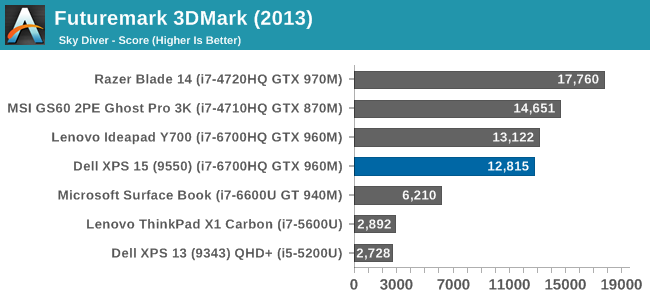
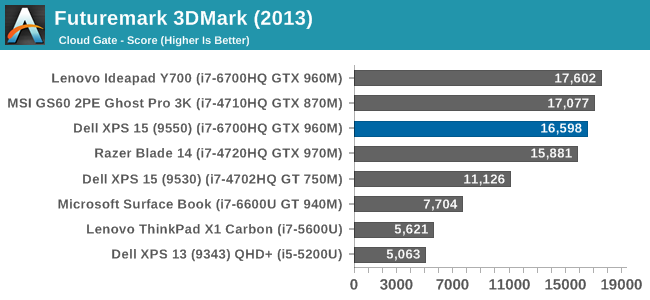
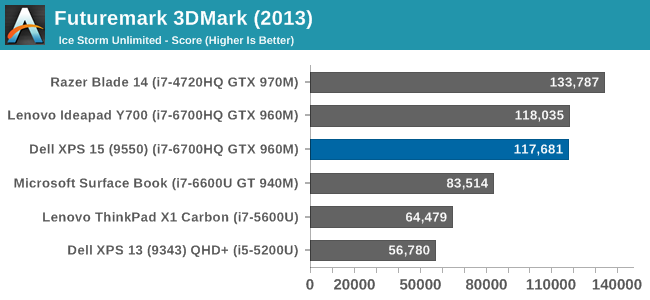
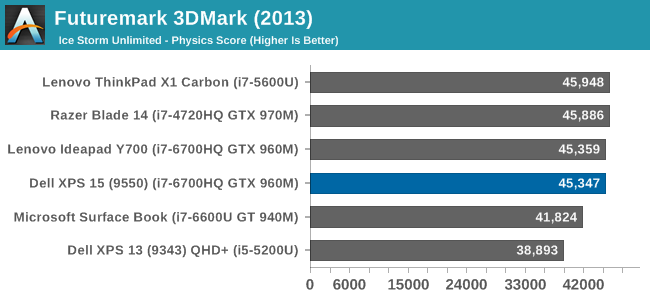
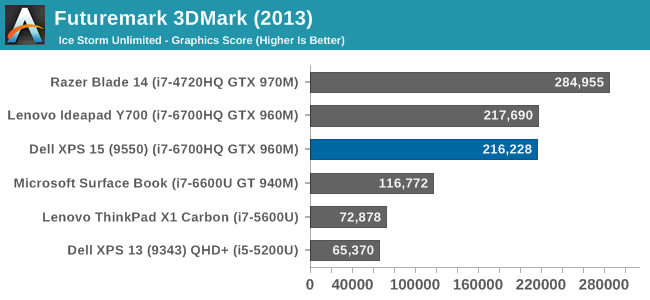
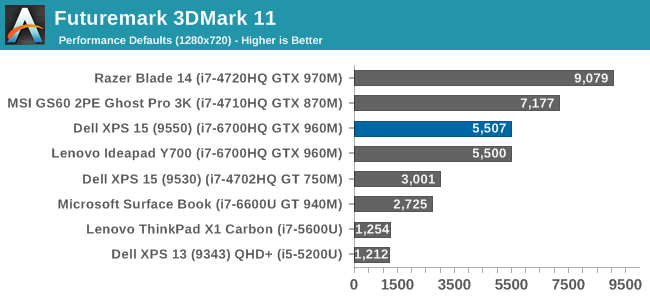
Our first synthetic test is FutureMark’s 3DMark. The latest 3DMark has several subtests, which start with the most demanding, Fire Strike, and decrease in demand going to Sky Diver, Cloud Gate, and Ice Storm Unlimited. The GTX 960M in the XPS 15 is fairly close to the Y700, which isn’t a shock, and the performance is a good step up from the GT 750M in the older XPS 15.
GFXBench
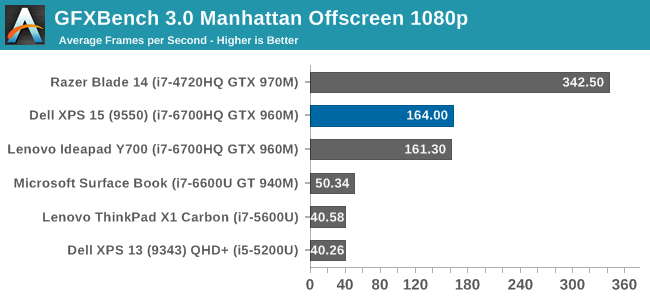
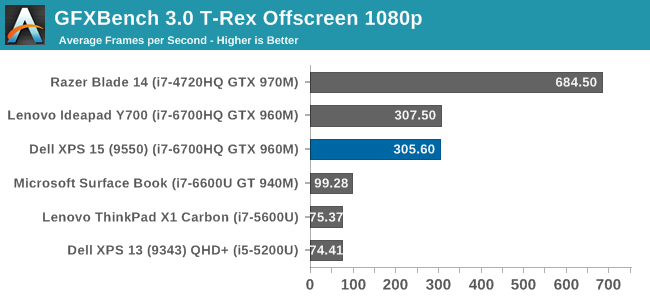
On our second synthetic test, we see the XPS 15 slotting right in around the same performance level as the Y700. Pretty much any PC with a discrete GPU can handle this benchmark at well over 60 FPS.
Dota 2
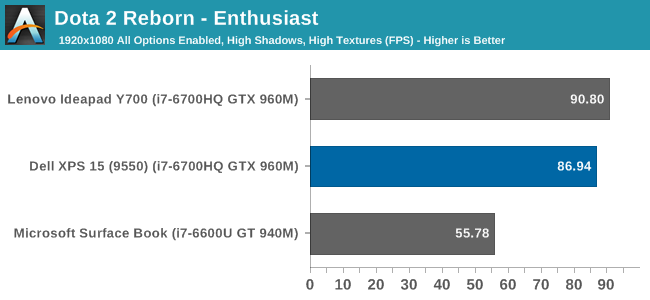
This Multiplayer Online Battle Arena game was recently revamped with a new game engine, which offers better visuals, but one that can still be played on low end hardware. The XPS 15 can handle this game very well at our enthusiast settings.
Tomb Raider
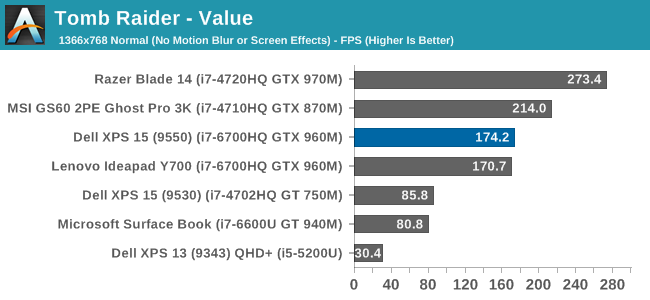
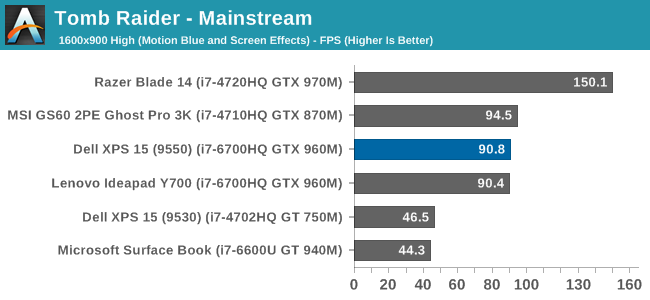

The latest version of this franchise has recently been released, but the original version can still be punishing on laptop graphics, especially with TressFX enabled. The XPS 15 can handle this game fairly well until you enable TressFX at 1920x1080, and then it struggles. It’s still a big jump over the older GT 750M equipped XPS 15.
Bioshock Infinite
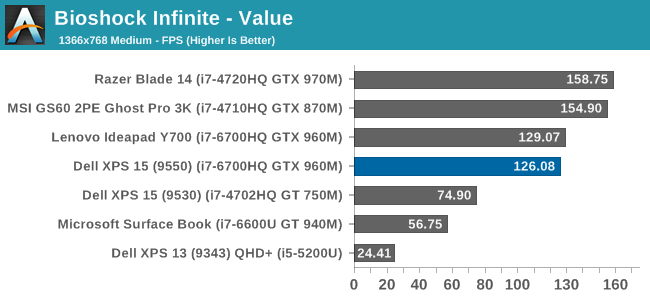

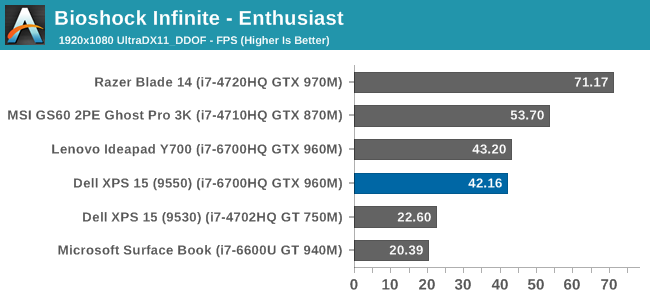
The XPS 15 can handle this game fairly well, but at the highest settings we test it will struggle. The performance is once again a big jump over the outgoing GT 750M, and the GTX 960M gives us over double the performance of the Surface Book’s GT 940M as well.
Dragon Age Inquisition



Bioware crafted a great game with Dragon Age Inquisition, and with maximum settings it can be punishing to lower end GPUs. The draw distances are quite impressive. The XPS 15 struggles at 1920x1080 Ultra, and some tweaking using the GeForce Experience would be needed to get an acceptable frame rate on this game. You can see that the XPS 15 pretty much mirrors the Y700 here, despite the Lenovo GPU having double the RAM on the GPU.
Shadow of Mordor



The well received action-adventure game from Warner Brothers and Monolith Productions uses the LithTech game engine, and with everything set to maximum at 1080p, the GTX 960M barely keeps an average over 30 frames per second, so once again this test is a bit too demanding for this laptop, but again the limited VRAM on the GPU does not seem to be affecting it at the resolutions and frame rates that the lower powered GTX 960M can achieve.
GRID Autosport



The EGO 3.0 engine can be tweaked quite a bit to allow this game to play on a large range of hardware. Even on maximum settings, the XPS 15 does very well.
GPU Conclusion
It’s great that we just reviewed another GTX 960M powered laptop, but it had the 4 GB version of the graphics card rather than the 2 GB version that Dell is shipping in the XPS 15. Despite half the memory, the graphics performance is pretty much even. It doesn’t seem to be a huge disadvantage with the games that we tested in any case. With higher resolutions, such as gaming at UHD resolutions, it would likely make a bigger difference, but the GTX 960M is already showing its performance limits at 1920x1080 gaming, so asking it to draw four times the pixels is likely a bit much.










152 Comments
View All Comments
Ryan Smith - Monday, March 7, 2016 - link
We've checked, and there's only a single drive (and not a RAID device) present in the Windows device manager.Soac - Wednesday, March 9, 2016 - link
I don`t think I have explained correctly. The Laptop came setup in RAID mode on the BIOS, from the forums I saw that it happened to everyone, and yes this is for the 1 single drive 512 samsung m.2. Hence why I said it didn`t make sense. However, if you change the BIOS setting to AHCI the read speeds go up to 1.7Gbps.-----------------------------------------------------------------------
CrystalDiskMark 5.0.3 x64 (C) 2007-2015 hiyohiyo
Crystal Dew World : http://crystalmark.info/
-----------------------------------------------------------------------
* MB/s = 1,000,000 bytes/s [SATA/600 = 600,000,000 bytes/s]
* KB = 1000 bytes, KiB = 1024 bytes
Sequential Read (Q= 32,T= 1) : 1723.554 MB/s
Sequential Write (Q= 32,T= 1) : 600.373 MB/s
Random Read 4KiB (Q= 32,T= 1) : 0.000 MB/s [ 0.0 IOPS]
Random Write 4KiB (Q= 32,T= 1) : 0.000 MB/s [ 0.0 IOPS]
Sequential Read (T= 1) : 0.000 MB/s
Sequential Write (T= 1) : 0.000 MB/s
Random Read 4KiB (Q= 1,T= 1) : 0.000 MB/s [ 0.0 IOPS]
Random Write 4KiB (Q= 1,T= 1) : 0.000 MB/s [ 0.0 IOPS]
Test : 1024 MiB [C: 21.6% (102.8/476.4 GiB)] (x5) [Interval=5 sec]
Date : 2016/03/09 23:13:32
OS : Windows 10 [10.0 Build 10586] (x64)
Funny enough, someone was saying that in RAID mode the drive felt faster... so it would be cool if you could test it.
medi03 - Sunday, March 6, 2016 - link
Would be interesting to see how it fares at gaming vs amd's carrizo notebooks.iks - Sunday, March 6, 2016 - link
While this is surely a great piece of tech, with a superb screen, capable hardware, and decent, cooling I still wonder, what is the target audience of this and other similar devices? Have the guys over at Dell and other companies actually tried to do productive work that involves a lot of typing on this so-called "keyboard"? Especially programming? Using impossible to hit buttons with no proper spacing, a short F row, minuscule arrows and no dedicated page up / page down / home / end. Sorry, but a keyboard like that is just dumb, and a torture to use.nerd1 - Sunday, March 6, 2016 - link
Say that to millions of mac users. Apple's DESKTOP keyboard is even worse than this.BPB - Monday, March 7, 2016 - link
I am a developer, and I use a company issued Dell at work (decent specs). The keyboard doesn't matter to me since I dock it at work. At home I leave it closed and plug a monitor/keyboard/mouse into it. So why should I care? I do occasionally use it by itself, but I don't mind since it's not very often. I guess what I'm saying is, how many developers use a notebook without plugging in peripherals?iks - Thursday, March 10, 2016 - link
Well, I'm learning to use Vim to overcome button limitations on the different keyboards I may get to work on in future. People work on 60% boards after all.As far as plugging peripherals in / out, aren't you afraid of the ports coming loose over time?
jasonelmore - Monday, March 7, 2016 - link
I wanted to point out that the laptop on this article has different materials depending on if you get the 1080p version vs the 4k version.The 1080p version has a lot more plastic vs the 4k one.
nerd1 - Monday, March 7, 2016 - link
1080p version lacks the glossy glass (which I hate), but it is identical elsewhere.rstuart - Monday, March 7, 2016 - link
I own one of these, but I run Linux. Typical Linux issues - if enable the NVidia card it doesn't boot, and it will be because NVidia hasn't released drivers for it yet. I'm mostly a command line user, so that doesn't worry me overly. The Intel drivers causing the kernel to crash 2 out of 3 boots on the other hand drove me nuts. The latest kernel has fixed that thank god, so it's rock solid now. I was surprised to read people running Windows are having the similar issues - here I was putting it down to Intel's poor support for Linux. It's more of a case of Intel not having good drivers, at all, on anything. Be patient, and be forgiving of Dell - it's Intel's problem, not Dell's.Apart from the display, it works extraordinarily well out of the box. As a Linux user, this is not something I'm used to. On the down side, there is not much in the box as Dell hasn't got their act together yet accessories - mostly because of the change to USB-C.
The one thing I do question myself about is going with the UHD display. It is gorgeous. But according to Dell the HD display roughly doubles the battery life, and in reality eye candy fade but not having to worry about charging during the day would have been appreciated for a long, long time.
One other feature not mentioned in the review is everything (battery, WiFi card, DIMM's, HDD/SSD, fans for cleaning) is accessible with the removal of 8 or so easy to find screws on the back. Unlike some other makes, Dell laptops have been getting better in this regard over the years.